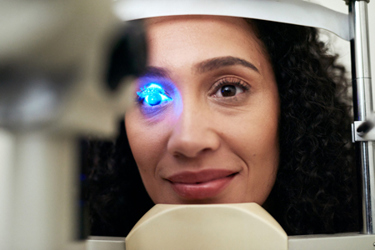Nanoscope Therapeutics Tackling Vision Loss With Ocular Gene Therapy

By Erin Harris, Editor-In-Chief, Cell & Gene
Follow Me On Twitter @ErinHarris_1

Nanoscope Therapeutics is a late-stage clinical biotech that develops gene therapies for inherited retinal diseases and age-related macular degenerations (AMD). Just recently, the company announced positive results after the completion of the 2-year Phase 2b RESTORE randomized, controlled clinical trial of its lead program, MCO-010, a mutation-agnostic gene therapy for patients with permanent and severe vision loss from advanced retinitis pigmentosa (RP).
Sulagna Bhattacharya, MBA, Co-founder and CEO; Samuel Barone, MD, Chief Medical officer; and Samar Mohanty, Ph.D., Co-Founder and President of Nanoscope Therapeutics answered my questions about the safety and efficacy data and next steps for RESTORE.
Tell us about Nanoscope Therapeutics and its pipeline.
Sulagna Bhattacharya, MBA, Co-founder and CEO, Nanoscope Therapeutics:
Nanoscope is a late-stage biopharmaceutical company at the forefront of bringing transformative mutation-agnostic therapies for restoring vision in retinal degenerative diseases with the highest unmet need. My uncle began to lose his vision in his early 20s and lost most of his vision by his late 30’s due to a retinal degenerative disease. Since then, it has been a dream and mission of mine to help others affected by inherited, blinding diseases. In 2017 I co-founded Nanoscope Therapeutics with Samar Mohanty, Co-Founder and President in response to witnessing what my uncle went through as his vision became progressively worse, making day-to-day life and activities nearly impossible. Today we are an advanced clinical stage company focusing on restoring vision for people suffering from retinal degenerative diseases, for which no cure exists. Nanoscope MCO is the only therapeutic platform that provides broadband light sensitivity with fast kinetics and ambient light activation for vision restoration. The results of this study reflect more than a decade of innovation across all aspects of the program, including vector design, manufacturing, and clinical trial design, as well as the development and validation of novel functional vision endpoints. It’s also an important moment for the field of gene therapy. I believe we are uniquely poised to turn optogenetics into a therapeutic reality not only for retinitis pigmentosa patients but also for people with other hereditary retinal degenerative diseases like Stargardt disease.
Explain RESTORE, the safety and efficacy data, and next steps for the trial.
Samuel Barone, MD, Chief Medical Officer, Nanoscope Therapeutics:
The success of RESTORE shows that there is real hope for patients suffering severe vision loss due to advanced RP. In this late phase, randomized, controlled clinical trial we observed very meaningful improvements as has never been before shown in an RCT for permanent retinal degeneration: visual acuity >0.3 LogMAR (>15 letter ETDRS equivalent) at primary (52wk) and key secondary (72wks) endpoints. The visual acuity gains occurred regardless of underlying genetic mutation and were supported by improvements on other functional vision assessments. We are motivated to get this to patients as soon as possible, and because this well-tolerated treatment is showing significant benefit in a high unmet need population, we are confident in the pathway to potential approval.
Why is gene therapy the most promising technology for the retinal diseases Nanoscope targets?
Samar Mohanty, Ph.D., Co-Founder and President of Nanoscope Therapeutics:
Since most rare diseases in the retinal degeneration space have underlying genetic mutations, gene therapies are going to be the obvious choice for restorative and durable outcomes. Our goal is to pioneer mutation-agnostic gene therapies that may be applicable to a broad population irrespective of the underlying mutation that is known to be associated with the disease or yet to be identified. Our clinical programs have shown that such mutation-agnostic therapies are safe, durable, and beneficial to patients.
In addition to RP, the results we’ve seen so far in Stargardt disease indicate that MCO treatment may also provide a benefit to patients with advanced age-related macular degeneration, specifically those suffering from geographic atrophy.
Our hope is that the groundwork we’ve done in this space will not only make it easier for our pipeline programs to advance at a rapid pace but also help other retinal gene therapy programs in development. Our view is that a historic opportunity for retinal gene therapies is emerging where technological advances, efficacious clinical data, and regulatory momentum are coming together in a way we haven’t seen before. We are excited to be part of this historic opportunity to serve patients with the highest unmet needs globally.
What’s next for RESTORE?
Samuel Barone, MD, Chief Medical officer, Nanoscope Therapeutics
We anticipate submitting a Biologics License Application (BLA) to the U.S. Food and Drug Administration in the second half of 2024.
